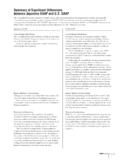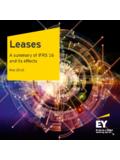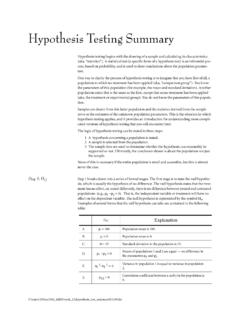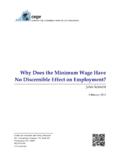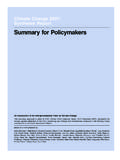Transcription of Overview of Differences between International …
1 Overview of Differencesbetween InternationalFinancial ReportingStandards and CzechAccounting Legislation20132 ContentsAuthors Comments4 financial Statements5 Property, Plant and Equipment10 Leases13 Borrowing Costs15 Investment Property16 Intangible Assets17 Inventories19 Share-based Payment21 Employee Benefits22 Provisions, Contingent Liabilities and Contingent Assets24 financial Instruments26 Non-current Assets Held for Sale and Discontinued Operations30 Revenue31 Construction Contracts34 Impairment of Assets35 Fair Value Measurement37 Income Taxes39 Consolidation and Business Combinations403 IntroductionInternational financial Reporting Standards (IFRS), a set of financial reporting standards issued by theInternational Accounting Standards Board (IASB) andrelated interpretations, rank among the most importantfinancial reporting standards in the world. These standardsdo not substitute generally applicable legislation, but forma principle-based accounting system designed primarily forlisted companies and large-scale businesses.
2 Theapplication of the standards requires considerableprofessional skills of the assigned not designated as generally applicable laws, IFRSmay be, to a greater or lesser extent, adopted in nationaland International legislation, depending on the type oflegal environment. In the Czech Republic, entities that arebusiness companies and issuers of securities listed in theregulated securities markets in the European UnionMember States currently use International FinancialReporting Standards as adopted by the European Union foraccounting purposes and for the preparation of financialstatements. Pursuant to an amendment to the AccountingAct, which came into effect on 1 January 2011, IFRS maybe applied in the preparation of separate financialstatements also by entities that are part of a consolidatedgroup that prepares consolidated financial statements inaccordance with to IFRS, Czech Accounting Standards (CAS) area national accounting system, based primarily on rules,which is subject to the EU regulatory requirements and theensuing obligations for the Czech Republic.
3 As thecornerstone of Czech accounting legislation in its broadersense, the Accounting Act is the fundamental, generallyapplicable regulation nationwide, setting out accountingpolicies and financial reporting for all entities in thecountry s territory, from the smallest to the largest(as well as multinational), whose scope and purpose ofbusiness may significantly differ. The form and content ofthe Act are governed not just by the requirements ofEuropean legislation, but also by Czech legislative rulesrequiring full compliance material and terminological with other regulations of the Czech legal system. Since theAct needs to be complied with as mentioned above evenby very small entities (sole traders, not-for-profitorganisations) that are unlikely to possess broadtheoretical knowledge of accounting and related fields, it isinstrumental that the text of the Act be as comprehensibleand unambiguous as factor affecting the Czech accounting rules andtheir application is that the income tax base is stillcomputed from results obtained in accordance with , in practice a great number of assumptionsmade by management in the preparation of financialstatements take into account potential tax implications ofthe selected accounting treatment.
4 That might result inadopting accounting opinions based on tax impacts ratherthan on considerations of how to present a true and fairview of a transaction in its that each of the systems is based on differentpriorities and principles, there are many Differences inboth conceptual and specific attributes. Any comparisonbetween the two systems is relatively difficult and hard toimplement in a simplified approach. Nonetheless, thisguide attempts to outline some of the Overview of Differences between InternationalFinancial Reporting Standards (IFRS) and CzechAccounting Standards (CAS) follows a similar guidepublished in 2009. Due to a number of changesimplemented in the meantime, we decided to publisha new, updated version for 2013. The guide is written fromthe IFRS perspective and the sections are organisedaccording to specific hope you find this guide do not hesitate to contact us with any Sk cel kPartnerE-mail: +420 225 335 375 Alice Machov Senior managerE-mail: +420 225 335 1694 Authors CommentsThis guide outlines the Differences between IFRS and CASat the general level.
5 For the purpose of this guide, IFRS mean a set of standards issued by the InternationalAccounting Standards Board, not International FinancialReporting Standards as adopted by the European guide is intended to provide general information onlyand is not for , no summary publication can fully encompass somany, often minor, Differences between IFRS and some degree of harmonisation of thefundamental principles of IFRS and CAS has beenachieved, there are still significant Differences in theirapplication that may have a material impact on financialstatements. The key focus is on the Differences mostcommonly found in practice. When applying individualaccounting frameworks, readers must take into account allrelevant accounting regulations, standards and, whereapplicable, national legislation in their respectivecountries. In addition, listed companies must comply withrelevant regulations related to securities legislation, suchas decrees of the Czech National International Accounting Standards Board is currentlydeveloping a number of projects that will mostly havea significant impact on the existing standards.
6 This guiderefers to IFRS standards effective at 1 January 2013 andcompares them with CAS that were in effect at 1 January2013. Where IFRS or IFRIC interpretations are mentionedthat came into force after this date, this fact is pointed outin the text. Czech Accounting Standards referred to in thisguide are those prescribed for entrepreneurs (except forspecific cases). The guide does not address any majordifferences pertaining to banks and other financialinstitutions, nor Differences regarding IFRS orinterpretations that are perceived as less relevant in theCzech environment. Similarly, numerous differencesbetween IFRS and CAS in disclosure requirements are notaddressed StatementsRelated IFRSs and IFRICs:IAS 1 Presentation of financial StatementsIAS 7 Statement of Cash FlowsIAS 8 Accounting Policies, Changes in Accounting Estimates and ErrorsIAS 21 The Effects of Changes in Foreign Exchange RatesIFRSCASF inancial statementsUnder IFRS, a complete set of financialstatements comprises: a balance sheet (nowknown as a statement of financial position),a statement of comprehensive income, ora separate income statement and a statement ofother comprehensive income (if preparedseparately from the statement of comprehensiveincome), a statement of changes in equity,a statement of cash flows, and notes (comprisinga summary of significant accounting policies andother explanatory information).
7 financial statements are prepared for the currentperiod and the prior period. If an entity restatescomparable information retrospectively, it shallalso prepare a statement of financial position asat the beginning of the comparative CAS, financial statements are an integralunit comprising: a balance sheet, an incomestatement and notes, including accountingpolicies and statements are prepared for thecurrent period and the prior period. Entities tendto prepare a statement of changes in equity asthe primary statement, but they are allowed toinclude it in the notes to financial statement of cash flows is not required, butmost entities choose to prepare IFRS, profit or loss is reported in thepresentation currency. However, the statementsmay be adjusted and presented in only allow the statements to be presented inCzech offinancial position formatIFRS do not prescribe any binding format fora balance sheet, but they set out the minimumscope. Entities classify assets and liabilities ascurrent and non-current, except whena presentation based on liquidity provides moredetailed prescribe a binding minimum scope, formatand description of items in an unconsolidatedbalance sheet.
8 Entities may choose to classifyitems in more detail or, in specified cases, groupthem format of the consolidated balance sheet isless of non-current itemsIFRS require that an entity distinguish betweencurrent and non-current items (unless thepresentation is based on liquidity).An entity shall classify an asset as current whenit expects to sell or consume the asset in itsnormal operating cycle; it holds it primarily forthe purpose of trading; it expects to realise itwithin twelve months after the balance sheetdate; or the asset is cash or a cash entity shall classify all other assets as entity shall classify a liability as current whenit expects to settle the liability in its normaloperating cycle or within twelve months after thebalance sheet date; it holds it primarily for thepurpose of trading; or it does not havean unconditional right to defer settlement of theliability for at least twelve months after thebalance sheet entity shall classify its financial liabilities ascurrent when they are due to be settled withintwelve months after the balance sheet date evenif the original term was for a period longer thantwelve months and an agreement to refinance, orto reschedule payments, on a long-term basis iscompleted after the balance sheet date andbefore the financial statements are authorisedfor entity shall classify all other liabilities as require that an entity distinguish betweencurrent and non-current items, except classification of tangible and intangibleassets depends on their expected useful life(one year or longer) and the acquisition cost limitset by the entity with regard to presenting a trueand fair view of the items.
9 Securities held for thepurpose of trading are classified as non-currentfinancial assets. The classification of receivablesand liabilities (including loans) depends on whenthey are due to be recovered/settled after thebalance sheet date (within one year or a periodlonger than one year).7 IFRSCASS tatement ofcomprehensiveincome formatUnder IFRS, the statement of comprehensiveincome shall include: profit or loss; othercomprehensive income; total comprehensiveincome (the sum of profit or loss and othercomprehensive income). The statement lists allchanges in comprehensive income that are nottransactions with entity may prepare a single statement (thelong form of the statement) or two long-form statement includes an incomestatement and a statement of othercomprehensive income. If an entity presents twostatements, it prepares a separate incomestatement and a separate short-form statementof comprehensive income. The short-formstatement only comprises total profit or loss(without displaying its components) andcomponents of other comprehensive income.
10 Thestandard does not prescribe any binding formatfor a profit or loss statement, but it sets out theminimum scope. Expenses must be disclosed byfunction or by updated IAS 1 requires grouping of items ofcomprehensive income depending on whetherthey can be subsequently reclassified to profit orloss; the items that can be reclassified andthe items that cannot be do not define a statement of prescribe a binding format for anunconsolidated income statement. Expensesmust be disclosed by function or by may choose to classify items in moredetail or, in specified cases, group format of the consolidated incomestatement is less of other comprehensive income areincluded in the summary of changes in equity(see below).Exceptional andextraordinary itemsIFRS do not specify the exceptional items category, but an entity presents separately itemsthat are material for the explanation of theentity s financial performance (due to theiramount, nature or effect on profit or loss).










